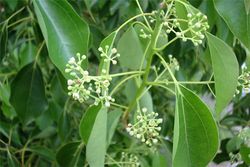Difference between revisions of "Ho leaf"
From Wikur Essential Oils and Fragrances
(→Chemical Constituents) |
|||
| Line 22: | Line 22: | ||
* [[linalool]] : 5,26 % | * [[linalool]] : 5,26 % | ||
* [[methyl eugenol]] : 5 % | * [[methyl eugenol]] : 5 % | ||
| − | |||
*[[beta-pinene]] : 2,98 - 3,61 % | *[[beta-pinene]] : 2,98 - 3,61 % | ||
* [[delta-3-carene]] : 3,52 % | * [[delta-3-carene]] : 3,52 % | ||
| Line 37: | Line 36: | ||
*[[terpinolene]] : 0,36 % | *[[terpinolene]] : 0,36 % | ||
*[[alpha-humulene]] : 0,79 - 1,63 % | *[[alpha-humulene]] : 0,79 - 1,63 % | ||
| − | *[[Beta-caryophyllene]] : 0,56 % | + | *[[alpha-caryophyllène]] : 0,92 % |
| + | *[[Beta-caryophyllene]] : 0,45 - 0,56 % | ||
*[[bicyclogermacrene]] : 0,39 % | *[[bicyclogermacrene]] : 0,39 % | ||
*[[germacrene D]] : 0,31 - 4,76 % | *[[germacrene D]] : 0,31 - 4,76 % | ||
Revision as of 12:52, 7 August 2016
Contents
Classification
- Botanical Name : Cinnamomum camphora
- Other Names : Ho Leaf Oil, Ravintsara, cinnamomum camphora linalooliferum leaf extract
- CAS Number : 92201-50-8
- Origin : Madagascar, Japan, Taiwan, China, India, Ceylon, Egypt, southern Europe, America
Extraction Method
- Parts Used : leaves
- Steam distillation
- Physical Description : colorless to pale yellow clear liquid
Olfactory Description
- Family :
- Perfumery Note: Top
- Fresh, earthy, eucalyptus, woody, peppery
Chemical Constituents
- sabinene : 12,98 %
- methyl chavicol : 7,94 %
- alpha-pinene : 5,55 %
- alpha-pinene : 5,39 %
- linalool : 5,26 %
- methyl eugenol : 5 %
- beta-pinene : 2,98 - 3,61 %
- delta-3-carene : 3,52 %
- myrcene : 3,43 %
- Beta-myrcene : 2,40 %
- delta-limonene : 0,98 %
- alpha-terpinene : 0,64 - 2,98 %
- Gamma-terpinene : 0,49 - 2,15 %
- alpha-phellandrene : 1,99 %
- camphene : 1,33 %
- beta-ocimene : 1,30 %
- alpha-thujene : 1,13 %
- para-cymene : 0,41 - 0,97 %
- terpinolene : 0,36 %
- alpha-humulene : 0,79 - 1,63 %
- alpha-caryophyllène : 0,92 %
- Beta-caryophyllene : 0,45 - 0,56 %
- bicyclogermacrene : 0,39 %
- germacrene D : 0,31 - 4,76 %
- alpha-selinene : 0,22 %
- alpha-terpineol : 9,87 %
- terpinen-4-ol : 4,09 %
- cis-thuyanol : 0,46 %
- 1,8-cineole : 1,08 - 58,88 %
